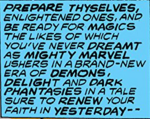Marvel Chillers #1 (Oct. 1975) was the first in a two-part story that brought Modred the Mystic from the time of King Arthur to the present. The title page of that first issue included a block of text announcing that Marvel was ushering in a brand-new era of stories with magics.
That new era did continue—with one caveat: most Marvel references to magic ending with the letter s favored an alternate spelling of magicks (with the letter k).
This nuanced spelling was evident when Modred guest-starred in Marvel Two-In-One #33 (Nov. 1977) and faced a mud-monster that spoke of Merlin's magicks (with k). While wielding the book Darkhold in Avengers #186 (Aug. 1979), Modred would boast how his raging powers now exceeded mere spells and magicks (with k).
Characters in other stories followed this spelling convention. When traveling back to 14th century England in Avengers #209 (July 1981), several of Earth's mightiest heroes again heard of magicks (with k). Likewise, in Marvel Team-Up #112 (Dec. 1981), Dr. Strange reflected on the arcane magicks of the serpent cult from #111.
A notable exception to this spelling trend appeared when Wong discussed magics (without k) in Dr. Strange #55 (Oct. 1982). Wong's spelling differed from the sorcerer's reference to his own magicks (with k) in Dr. Strange #34. That being said, there's no evidence that Wong's definition differed from that of Dr. Strange.



































